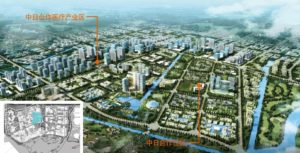
What is the policy, vision, or objective of the town? Please specify the actual goal and its metrics, if applicable.
The project aims to build a Japan-China cooperation community in the project area and to encourage Japanese companies to set up operations there. Currently, Japanese companies such as Nomura Research Institute (development strategy), Nikken Sekkei (planning), Daiwa House Industry (real estate development) and Sharp (HEMS) are participating in the eco-city development project. The project aims to achieve an energy saving rate of 65% for newly-built houses and 50% for public buildings; build city-wide networks of pedestrian and cycling roads; meet more than 60% of the annual hot water demand with solar thermal water heaters; and achieve a 100% utilisation rate of renewable energy including wind and PV power generation, solar thermal and geothermal heat.
Brief outline of the low carbon town development plan
A new city with an ecological profile will be developed in the Tangshan region approximately 250 kilometres east of Beijing. Sweco is engaged for a series of efforts to ensure that environmental aspects are taken into consideration. Around one million people are expected to live in the eco-city in the future.
”China is in great need of new cities that can relieve the pressure on the country’s congested and polluted mega-cities. Sweco has worked in the country over the last eight years and has developed a number of cities and communities with ecological profiles, but this is the largest assignment so far,” says Eva Nygren, Managing Director for Sweco Sweden.
The new city will consist of 150 square kilometres with an initial stage that will have a scope of 30 square kilometres. A deep-water port and industrial area are also being planned in conjunction with the city. Sweco shall formulate a sustainable strategy based on the planning proposals that exist for the initial stage of the city. The goal is to integrate the proposals and ensure that the various environmental aspects are taken into consideration.
”A major challenge with this project is to find solutions to tie the long-term planning of the entire region together with the construction of the initial stage of the city, which will be completed in 2020. An important goal in all the planning is to find integrated solutions for energy and the environment that reduce the emission of greenhouse gasses, and through that, global warming,” says Ulf Ranhagen, senior architect at Sweco and professor at KTH (Royal Institute of Technology), who is project manager for the assignment.
What indication will you use to monitor CO2 reduction in each sector? Who is responsible for establishing and keeping of the indicators?
"The Swedish company responsible for master planning, Sweco, proposed 141 indicators. There are 109 indicators for planning, consisting of three levels. The first 68 indicators are set for the master plan level, then there are 16 at the development control plan level, and finally 25 indicators at the site level. The remaining 32 indicators are management criteria." – Wu, Fulong. Planning for Growth: Urban and Regional Planning in China. 2015
What central/local government departments are/will be involved in development of the project?
Caofeidian International Eco-city Investment Co Ltd, Caofeidian Jiaxiang Real Estate, Beijing Golden Tech, Nomura Research Institute
What private company, non-government ogranizations are/will be involved in development of the project?
SWECO of Sweden (urban development plan), Nikken Sekkei, Daiwa House Industry, Sharp